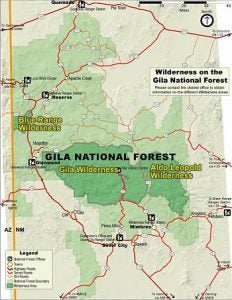Just one year after cattle were gunned down in New Mexico’s Gila Wilderness, ranchers have received an impound notice from the U.S. Forest Service, potentially setting the stage for more aerial cattle shooting.
Allotment owners near the Gila Wilderness received a Notice of Intent to Impound Unauthorized Livestock on Feb. 1. The impound notice indicates that unauthorized livestock may be impounded as soon as this week.
That’s only two weeks’ notice to remove estray livestock out of a 559,688-acre rugged wilderness area in the middle of winter in an area only accessible on foot or by horseback.

Ranchers whose cattle are impounded will be allowed to regain possession of their cattle, but only after they’ve reimbursed the Forest Service for the cost of impounding, feeding, and care of livestock up to or equal to the animal’s fair market value. Producers will have five days after printed notice of livestock impounding to redeem their cattle — those not claimed will be sold at a public sale, condemned, destroyed, or otherwise disposed of.
However, most of these cattle aren’t likely owned by surrounding ranches. The New Mexico Cattle Growers’ Association writes, “Since the grazing allotments in the Wilderness are vacant, the ranchers bordering the area have solely carried a load of infrastructure repairs and responsibility thrust on them by a negligent agency.” Still, the association argues that gunning cattle down and leaving their carcasses to rot isn’t the solution.
Estray, feral, and maverick (or unbranded) cattle have inhabited the Gila Wilderness — one of the oldest wilderness areas in the country — since the 1970s. According to reports, the U.S. Forest Service began its efforts to remove cattle in the 1990s. Since then, over 700 cattle have been removed from the area, but the U.S. Forest Service estimates that up to 150 cattle remain in the wilderness area.
Last February, aerial gunning operations resulted in the shooting and killing of 65 head of cattle. The decision to gun down estray cattle came on the heels of a Center for Biological Diversity lawsuit for damages to riparian areas.
The New Mexico Cattle Growers’ Association says they fear the notice is, “Unquestionably a step toward another aerial gunning mission.” The association’s leadership and other industry stakeholders have been trying to encourage the use of water and feed traps using pens, fencing, and roads so that livestock can be ethically removed.
»Related: Forest Service clamps down on N.M. family’s herd, sparking pro-ranching rally
Heidi Crnkovic, is the Associate Editor for AGDAILY. She is a New Mexico native with deep-seated roots in the Southwest and a passion for all things agriculture.



